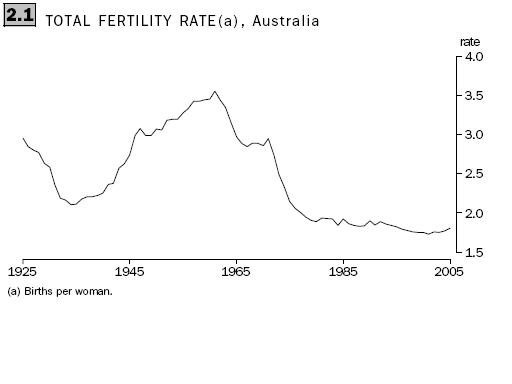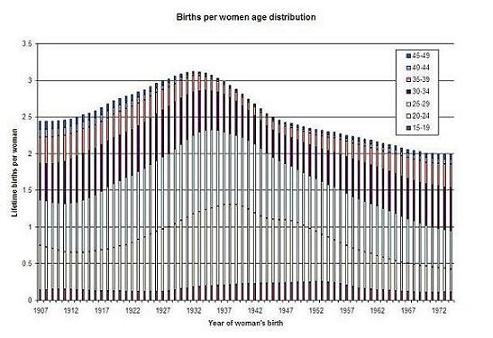Last month, when releasing the census with great fanfare, Peter Costello once again took credit for the recent slight rise in the birth rate. For the record, Australia’s fertility rate increased to 1.81 births per woman in 2005, up from 1.77 the year before. The replacement rate (the average number of babies a woman needs to have in her lifetime to keep the population steady) is 2.05.
It’s seemed to me for a while that the steady decline that’s been happening in fertility rates is about far more than women having fewer babies. It’s also a major change in the life pattern of women as people and mothers.
Here’s the graph of fertility rate for the last eighty years. You can see that there is a lot of variation (source Australian Bureau of Statistics).
But here’s the rub. The fertility rate you see on this graph is the average rate of all women having babies at any given time. My (so far ancedotal) view has been that in the last 20 years, there has been a major shift in behaviour. Women are having more of their children in their 30s than their 20s. And as this shift in behaviour works its way through the age scales, there has been a lack of babies. The women born in the 50s finished their families in their early 30s, and the women born in the 60s waited out their 20s and started in their 30s. A gross generalisation, of course.
But the census prompted me to have a look at the statistics in more detail. So its possible to create the graph below, which is a projection of the lifetime births per woman by year of birth from the birth statistics. Its a projection for the last 10 years of the graph, but that doesn’t make a major difference to the overall picture (Source Australian Bureau of Statistics plus my own analysis).
While the rate of children per woman has been decreasing (from a peak of just over 3 for women born in the mid 30s) it is much smoother, and we’re still pretty close to the replacement rate for women like me (born in the late 60s).
So I don’t think Peter Costello’s Baby Bonus had much to do with fertility changes at all – it’s just that the women born in and around 1971 (the peak number of births in Australia’s history still) are getting to around the peak of their peak childbearing years – the mid 30s.



Is that a demographic thing? Certainly in our little pocket of London, thirties is without doubt the childbearing ‘norm’. But only for middle class white women in ‘professional’ jobs (I realise I’m generalising like mad here). A couple of miles away, it’s a very different picture.
I get so annoyed by Peter Costello congratulating himself on the baby bonus. Does he think people are totally innumerate? How much childcare does $3000 translate to? Two months in a centre around here. Oh wow, and now it’s increased to $4000. I know it’s illogical but I get annoyed that my decision to have a baby coincided with him bringing the baby bonus out – what if he thinks he influenced me?! Gaaaaaaahhhhh!!
“My (so far ancedotal) view has been that in the last 20 years ago, there has been a major shift in behaviour. Women are having more of their children in their 20s than their 30s.”
I’m surprised you say this as I thought it was the opposite – the average age of first baby has risen to somewhere in the 30s and the number of women having babies in their 40s has risen dramatically (though still a small proportion.)
Oops, sorry suzoz – swapped the numbers around and completely destroyed my argument! I agree. Women are having their babies in their 30s, rather than their 20s, and the delay of getting there is why our overall birth states have been so low for the last 10 years.
I’ve fixed it now.
Thanks. A most interesting analysis.